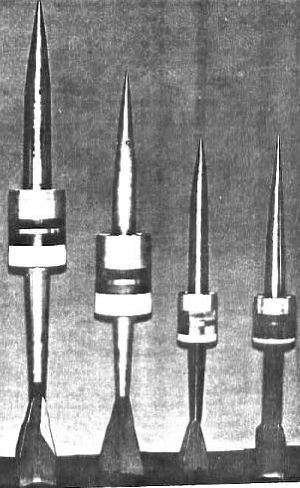
Home - Search - Browse - Alphabetic Index: 0- 1- 2- 3- 4- 5- 6- 7- 8- 9
A- B- C- D- E- F- G- H- I- J- K- L- M- N- O- P- Q- R- S- T- U- V- W- X- Y- Z
7 inch HARP Gun
 HARP 7 & 5 in probes From left to right: HARP 7-1, 7-2, 5-1, and 5-3. |
AKA: Gun07;High Altitude Research Project. Status: Retired 1969. First Launch: 1968-04-12. Last Launch: 1969-07-25. Number: 15 . Payload: 18 kg (39 lb). Height: 1.41 m (4.62 ft). Diameter: 0.18 m (0.59 ft). Apogee: 105 km (65 mi).
The 7 inch gun launcher was created by smooth boring a 175 mm gun and extending it in a similar manner as the 5 inch gun system. The completed gun barrel was 16.8 m (55 feet) long (7 inch L 92.4) and was installed in a modified T-76 mount. Two of the new guns were constructed. The 7 inch guns had 3 times the payload capacity of the 5 inch guns and an altitude capability in excess of 100 km. The 7 inch guns filled the altitude gap between the maximum 5 inch gun altitude and the minimal attractive altitude for 16 inch gun probes.
The original HARP 7-1 gun probe was fundamentally a scaled up version of the 5-1 gun probe and was used for similar payloads.. The 7-1 probe had a mean diameter of 91 mm, a length of 1640 mm, and a flight weight of 27.3 kg. The vehicle was launched at a velocity of 1650 m/s (5400 ft/sec) with a 50 kg (110 lb) charge of M17 propellant.
The 7-1 probe, although serviceable as an atmospheric tool, failed to reach its theoretical apogee in test flights. Although directly scaled from the 5-1 vehicle, it was not optimal for the 7 inch gun ballistics and was simply too heavy. A new vehicle was designed to take these factors into account and the 7-2 probe was created.
The Harp 7-2 vehicle was an optimized version of the 7-1 vehicle. The 7-2 had a body diameter of 76 mm a length of 1410 mm a flight weight of 18.2 kg and a payload volume of 2048 cc. The 7-2 prove was designed with a much-improved streamlined shape and exhibited far cleaner aerodynamics. The smaller 7-2 probe was capable of reaching altitudes of 105 km which allowed it to carry payloads through the D-layer and into the lower E-layer of the ionosphere - the very edge of space itself.
The 7-2 probe was used for a multitude of payloads including the standard ejectable chaff flown in the 5-1 probes. Of note was the 7-2 probe's ability to carry chemical payloads such as cesium nitrate, which was used to create artificial electron clouds, and to carry Langmuir probes with associated radio telemetry.
The 7 inch gun system proved to be an economical and versatile system. It was not long after HARP began to explore the feasibility of gun-launched rockets that a rocket boosted vehicle was proposed for the 7 inch gun system.
The gun-launched rocket vehicle for the 7 inch gun system was called the Martlet 3E. The Martlet 3E vehicle was a full bore rocket assisted vehicle 2248 mm long with a flight weight of 61.2 kg and a rocket fuel weight of 42.6 kg.
The development of the Martlet 3E vehicle was nearly complete when funding for the HARP program was cancelled and it would have become operational the year following the end of the program. The Martlet 3E vehicle was capable of carrying a 20 kg payload to an altitude of 250 km which was well in excess of the 16 inch Martlet 2C vehicle's performance. With its portable 7 inch gun the Martlet 3E would have allowed high altitude soundings to be conducted from a vast number of sites around the world. With a launch cost similar to that of the Martlet 2 series, the Martlet 3E would have replaced the Martlet 2, freeing up the fixed 16 inch guns so that they could be dedicated to satellite launches. It is interesting to note that even today HARP's 7 inch gun system could fulfill many of the current research requirements for a cost per flight much less than that of conventional sounding rockets..
The 7 inch HARP gun system proved to be a valuable atmospheric research tool with some 60 operational flights over a 3 year period. Perhaps the least recognized gun system of the HARP program, the 7 inch HARP guns were poised to prove just how versatile and valuable a research tool they could have been when, in 1967, the HARP project abruptly ended leaving their true potential unfulfilled.
by Richard K Graf
Payload: 18 kg (39 lb) to a 105 km altitude. Launch Price $: 0.001 million in 1962 dollars.
Family: Gun-launched. Country: Canada. Spacecraft: HARP 7-1, HARP 7-2. Launch Sites: Wallops Island, Barbados site. Stages: HARP-1. Agency: Bull. Bibliography: 2.
Back to top of page
Home - Search - Browse - Alphabetic Index: 0- 1- 2- 3- 4- 5- 6- 7- 8- 9
A- B- C- D- E- F- G- H- I- J- K- L- M- N- O- P- Q- R- S- T- U- V- W- X- Y- Z
© 1997-2019 Mark Wade - Contact
© / Conditions for Use